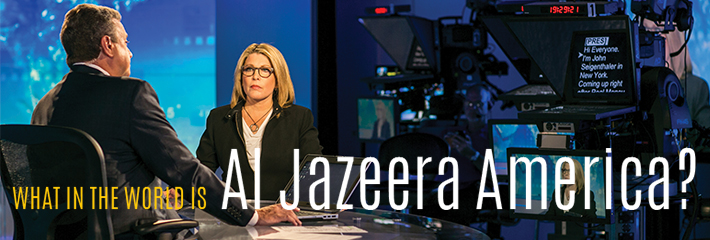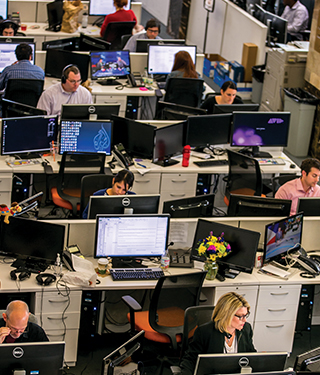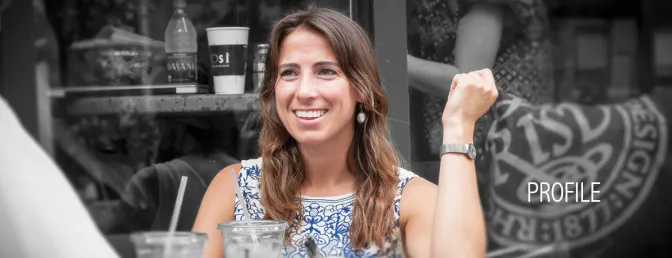
What in the World Is Al Jazeera America?
Mary Caraccioli’s brand of 24-hour news isn’t business as usual.
It was just after 1 p.m. on Aug. 20, 2013, when Mary Caraccioli cut off the debate and focused on getting her newscast ready for air. In less than three hours Al Jazeera America’s first live broadcast would enter more than 40 million homes across the country, making it perhaps the most highly anticipated media event of the year. Everyone was tense.

“The hardest part was keeping everyone’s nerves in check,” recalls Caraccioli on a late June afternoon while sitting at her workstation inside a former Manhattan bank now converted into the network’s temporary, incubatory home. “I thought of it like the Super Bowl. It’s just a regular game, but a lot more people are suddenly watching you and scrutinizing things, which puts people on edge. So at 1 o’clock I just said, ‘We’ve got this.’”
Caraccioli, who had been hired in May as the fledgling network’s senior executive producer of evening news, was chosen to cut AJAM’s broadcast ribbon because she was no stranger to launching new programs. Over the course of her career as both a producer and on-air anchor and reporter, the Drexel LeBow MBA alumna had created Good Day Philadelphia for Fox-29, Money Matters Today for Comcast and two nationally syndicated financial programs for ABC, including Mary Talks Money, which she hosted.
But the pressure of that August afternoon, even by Caraccioli’s own admission, was something entirely different. With brand new employees still walking into the newsroom just hours before the show was about to begin, everyone’s eyes were trained on AJAM, including several high-ranking executives who had flown in from the network’s flagship headquarters in Doha to watch the rollout. Moreover, dozens of U.S. press outfits watched from inside and afar, some of them chomping at the bit to throw stones of skepticism at the new kid on the media block.
“While journalists may be eager to join a news outlet that promises to air in-depth coverage, media analysts wonder how excited American viewers will be about a Middle Eastern-owned news operation with a controversial past and a programming approach that avoids shrill partisan voices,” wrote Roger Yu in USA Today the week of the launch.
But it was those precise challenges — along with AJAM’s commitment to so-called independent, boots-on-the-ground journalism — that excited Caraccioli about her new job in the first place. After all, with a resume like hers, one assumes Caraccioli could have chosen far easier roads than this one, which required moving her husband and 8-year-old daughter from Philadelphia to New York City to take on an extremely demanding job at a network with an entirely uncharted future.
“I never looked at this job as a risky move. Instead, I saw it as the place to be in TV journalism,” says Caraccioli, who currently manages a staff of more than 50 and produces two live, nightly newscasts five days a week. Arriving at AJAM around 9 a.m. each morning and departing for her uptown apartment about 9:30 every night (at the earliest), Caraccioli’s schedule is not to be envied. The job, on the other hand, is.
“There are very few places where the individual can have an impact on each day’s newscast and develop the structure for an entire network,” she says. “If I didn’t love this, I would be a fool.”
The seeds of Caraccioli’s passion for news media were first planted when she enrolled as an undergraduate at the University of Pittsburgh, where she immediately started contributing to the university’s newspaper and radio station while working toward a degree in English.
“I immersed myself in media from day one, but I really had no career aspirations,” says Caraccioli. “I just thought it was extremely interesting and a lot of fun.”
Regardless, a career in broadcast news began to take shape. By 1991 Caraccioli was the producer for CNBC’s morning business news program, a position she held for three years before moving on to executive producer of the 10 o’clock news for Fox-29 in Philadelphia while also creating the city’s Emmy-award-winning morning show.
Then, during her latter years at Fox, Caraccioli felt like she needed to make a change. One day, while stressing over staff vacation schedules and a whole host of tedious administrative tasks, Caraccioli suddenly realized the job had become more about management and less about news. She needed to “get closer to the story.” And that’s when she decided she wanted to be on the air.
“I was in my mid-thirties at the time, and for a woman on camera that’s when you typically start to hit your expiration date,” recalls Caraccioli. “So it was kind of a brave thing to do. It took a lot of courage. And I was really proud of myself for taking that step.”
Within six months of making that decision, Caraccioli landed her first on-air gig as a business reporter for the now-defunct Philly TV News. Less than a year later she was hired by CN8 to host Money Matters Today, a live nightly business and finance program that was seen in more than 10 million homes. After that Caraccioli went on to host two personal finance programs for ABC, Mary Talks Money and We Owe What?, which were both seen in some of the country’s largest markets. Oh yeah, and somewhere in the midst of all this she decided to earn her MBA from LeBow in 2008.
Now, having come full circle, Caraccioli once again finds herself behind the camera, and it’s quite possibly the most rewarding career choice she’s made so far.
“When I started working on the pilot for Good Day Philadelphia, I said to myself, ‘Enjoy this, because you’ll never get a chance to create another show again.’ And then I had the chance to create three more. But never, ever, did I think I’d have this kind of fun,” says Caraccioli. “I’m doing something that a lot of people in this business would love to be doing. And it’s pretty cool to be in that spot.”
Standing in the dark, heavily air-conditioned control room on the basement floor of AJAM’s New York City headquarters, Caraccioli puts on a headset and readies herself for the 8 p.m. newscast like a NASA flight director preparing a shuttle for launch. With the exception of asking that a chair be moved out of the opening shot, Caraccioli is mostly quiet. The show is largely in the hands of her team now.
“If I’ve done my job, there isn’t much micromanaging happening down here,” she says. “This is what we work toward all day.”
And this day, like most, has been a long one. It began at 9:15 a.m., when Caraccioli stepped into the first of three editorial meetings to discuss the day’s most important news stories with her staff. These included the discovery of three murdered Israeli teens who had been abducted while hitchhiking home from a West Bank settlement; a Supreme Court ruling that two for-profit corporations were within their rights to deny certain types of contraceptives to employees on the basis of religious objections; President Obama declaring that he would be requesting $2 billion in emergency funds to stem the influx of undocumented immigrants at the border; and General Motors announcing safety recalls involving more than 6 million vehicles.
Even though she’s the one who has final say on what AJAM’s viewers will be watching at 8 and 11 p.m., Caraccioli’s job is about more than just grabbing captivating headlines and throwing them onto the screen each night.
“By 8 and 11 p.m., the momentum of the morning’s top news stories will shift in a big way, so I always need to ask myself and my staff, ‘Where does this story go next,’” she says. “Our audience knows the headlines. They’ve seen them on their smartphones and tablets all day. Why would you watch at 8 unless there’s a reason beyond the headline? That’s what I need to figure out.”
What’s more, a great deal of Caraccioli’s time is spent answering a question that seems pervasive in every editorial discussion she and her staff have throughout the day: What is an Al Jazeera America story? After all, the entire reason AJAM exists is to rise above the politicization and sensationalizing of contemporary TV news in America. And this, she says, is one of the most thrilling challenges of shaping a brand new network.
“Here’s what you’re not going to see: You’re not going to see a story about the Kardashians. You’re not going to see us following every moment of the Oscar Pistorius trial. Sure, we’ll report the verdict, but the ins and outs of that trial are nothing more than sensational interests. There’s no value there,” says Caraccioli. “Of course you don’t want to be oblivious to what is interesting to people, but you don’t want to pander to them either. That’s what makes us different.”
To make that distinction Caraccioli says she relies on two things: instinct and an unyielding respect for her viewers.
“I’ve done this for my whole career, and I have a really strong sense of television. It’s in my DNA,” says Caraccioli. “I have a great deal of respect for who’s watching. And I’m constantly worried about what our viewers need to understand the story more deeply. When you’re rooted in that line of thinking, you’ll make good decisions.”
For too long now, Caraccioli says, America’s television news empires have been making poor editorial decisions, primarily because they are driven by profit and not the intellectual hunger of their audiences. In that regard, AJAM has a few advantages.
For one, Al Jazeera’s international presence is virtually unparalleled, with nearly 70 bureaus positioned around the globe and readily available to Caraccioli on any given day. What’s more, since the network is funded by the oil-rich Persian Gulf state of Qatar, AJAM has a bit of monetary latitude that allows it to forgo the ratings chase in lieu of straight-laced journalism. In turn, Caraccioli is able to make editorial choices one might not see on the Big Three cable networks.
Consider, for instance, the way she decided to cover the federal government shutdown last September. While mainstream outlets like Fox News and CNN scrambled to book politicians for their news shows, Caraccioli found a Head Start preschool teacher in Alabama who was getting laid off because of the shutdown and the owner of an inn just outside Yosemite National Park who broke down in tears while explaining that he didn’t know whether he was going to be able to pay his mortgage or make payroll.
“I had no interest in hearing from politicians. I knew their talking points already. And that’s theater. A horse race. And I don’t want that,” says Caraccioli. “I want to know who is affected. That’s what this is all about. I don’t want to be business as usual. That’s everyone else, and no one needs more of that.”
Back in the control room at 8 p.m., Caraccioli watches as the show goes live as the network’s fill-in anchor, David Shuster, outlines the evening’s top stories. The first half hour will dig deeper into the story about the murdered Israeli teens, the escalating violence in Iraq, the Supreme Court’s contraception decision and then a quick preview of an upcoming World Cup match between the U.S. and Belgium. Then, at 8:30, the newscast will devote its entire second half to an emotional and elucidating special called “Broken Borders, Broken Dreams,” which explains the causes of America’s immigration crisis and what can be done to fix it.
It’s a moving and intriguing hour of news that goes off without a hitch, and as Caraccioli takes off her headset, works her way back up to the newsroom and prepares to do it all again tomorrow, one can’t help wonder: How does she define success at the end of the day?



